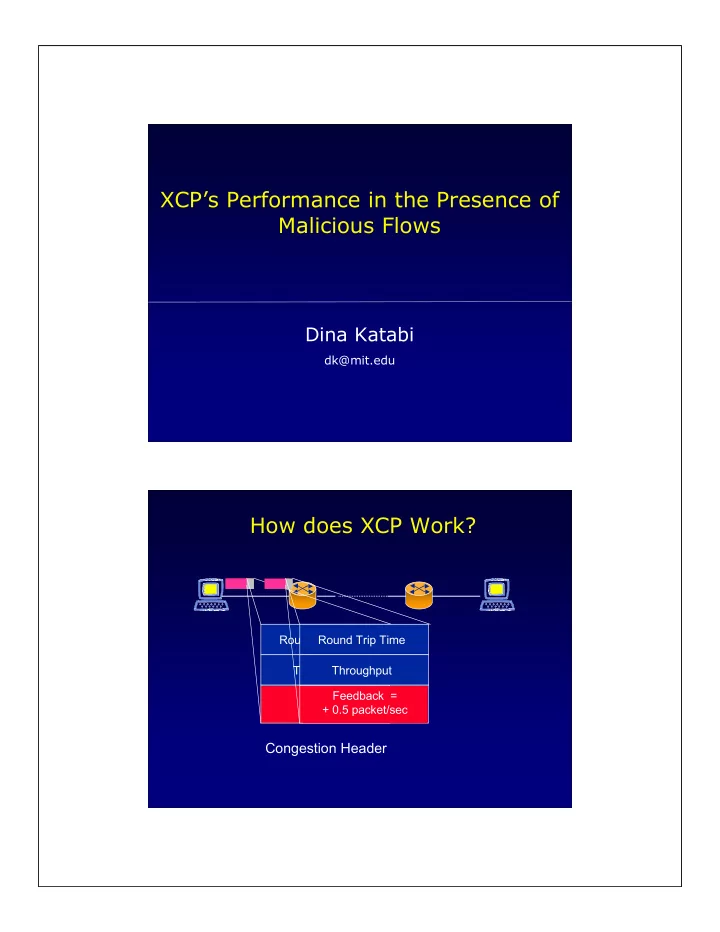

XCP’s Performance in the Presence of Malicious Flows Dina Katabi dk@mit.edu How does XCP Work? Round Trip Time Round Trip Time Throughput Throughput Feedback Feedback = Feedback + 0.5 packet/sec Congestion Header
How does XCP Work? Round Trip Time Throughput Feedback = Feedback = + 0.5 packet/sec - 0.3 packet/sec How does XCP Work? Cwnd = Cwnd + Feedback * RTT
Decouple Congestion Control From BW Allocation Policy 1. Congestion Controller 2. Fairness Controller How Does an XCP Router Compute the Feedback? Congestion Controller Fairness Controller Goal: Divides Δ between Goal: Matches input traffic to link capacity & drains the flows to converge to Reaction is prop. to Spare AIMD queue fairness Reaction is prop. to Spare AIMD and Queue. and Queue. De-allocation is prop. to De-allocation is prop. to Update every avg. RTT throughput Update every avg. RTT throughput Algorithm: Algorithm: Every Avg. RTT, If Δ > 0 ⇒ Divide Δ equally Aggregate traffic changes by Δ between flows Δ ~ Spare Bandwidth If Δ < 0 ⇒ Divide Δ between flows proportionally to their Δ ~ - Queue Size current rates quick response (shown to achieve Fairness [Jain])
What if sources are malicious? Will lie Will lie Will ignore about about RTT feedback throughput Can combine malicious attitudes! What if sources are malicious? Will lie Will lie Will ignore about about RTT feedback throughput
Does lying about throughput affect utilization? No. congestion controller makes the aggregate increase/decrease proportionally to the spare and the queue Simulated 20 flows all lying about their throughput: Utilization True Throughput / Reported Throughput Does lying about throughput affect fairness? Yes. Liar simulates multiple flows gets multiple fair shares Simulated one Linear Liar’s Throughput Other liars with 20 behavior flows good flows cwnd=1 will keep cwnd=1 True Throughput / Reported Throughput
What if sources are malicious? Will lie Will lie Will ignore about about RTT feedback throughput Does lying about RTT affect utilization? Yes. congestion controller makes decision every avg. RTT The liar can confuse the congestion controller! Simulated 20 flows lying about RTT: Utilization All RTT-Liars 50% RTT-Liars True RTT/ Reported RTT Performance stays good when a limited number of flows lie Performance stays good when a limited number of flows lie about their RTTs about their RTTs
Does lying about RTT affect fairness? No. It increases variance in the fair share but does not increase absolute throughput much Liar’s Throughput Normalized Simulated one liars with 20 good flows a) No big incentive for senders to lie about RTT a) No big incentive for senders to lie about RTT b) Can improve robustness to RTT-lies by making decisions True RTT / Reported RTT b) Can improve robustness to RTT-lies by making decisions every 100 ms rather than every Avg. RTT, but that would every 100 ms rather than every Avg. RTT, but that would reduce responsiveness reduce responsiveness What if sources are malicious? Will lie Will lie Will ignore about about RTT feedback throughput
When a flow ignores the feedback, the router tries to balance the utilization given the leftover capacity CBR Throughput CBR Throughput Utilization Solution: Sample & Test Solution: Sample & Test With probability p=0.05 sample the flows With probability p=0.05 sample the flows Send the flow negative feedback & monitor it for 5 avg. RTTs Send the flow negative feedback & monitor it for 5 avg. RTTs CBR sending rate/ Capacity If the flow doesn’t react, punish it If the flow doesn’t react, punish it Next with XCP TeXCP: Using the XCP Framework for Traffic Engineering
Intra-Domain TE Egress 1 Ingress 1 Egress 2 Ingress 2 Each ingress-egress pair has traffic demands Intra-Domain TE Egress 1 Ingress 1 Egress 2 Ingress 2
Intra-Domain TE Egress 1 Ingress 1 Egress 2 Ingress 2 Multi-path routing to minimize max utilization Why Minimize the Max. Utilization ? • Removes hot spots • Deals with link failures • Deals with unpredictable traffic spikes, flash crowds, and worm spreading Prior work uses offline approaches (e.g., OSPF optimal weight setting)
TeXCP: Online In-Network Approach for Minimizing Max Utilization • Multi-paths between ingress-egress pair Paths are tunnels pinned using MPLS • Think of ingress-egress tunnels as flows • Generalize congestion control One path Multi-paths 100% utilization Balanced utilization • Replace congestion header with occasional control packets on the slow path Easy to deploy in router software Doesn’t assume XCP Reaction to Link Failure Abilene Topology & Scaled Traffic Matrix OSPF Optimal Weight Setting TeXCP
Reaction to Link Failure Abilene Topology & Scaled Traffic Matrix OSPF Optimal Weight Setting TeXCP TeXCP reacts quickly and optimally to link failures because TeXCP reacts quickly and optimally to link failures because it reacts in real-time it reacts in real-time Conclusion • Lying about a flow’s throughput can increase BW share but doesn’t affect utilization • Lying about the RTT can degrade utilization Need a large number of liars to degrade performance unlikely given that it does not benefit the source • Ignoring the feedback can result in a larger BW share Deal with it using sample & test • XCP framework can be used for online in- network traffic engineering Easy to deploy with only changes to the slow path
Recommend
More recommend